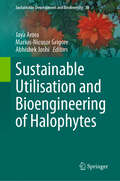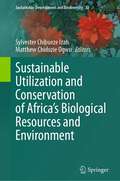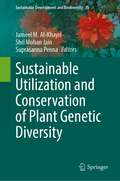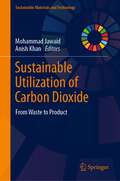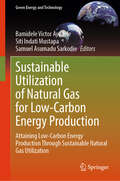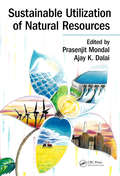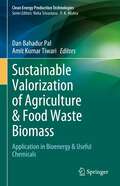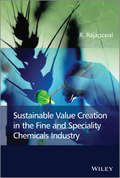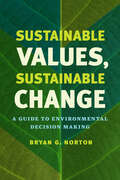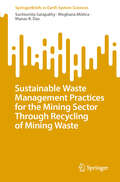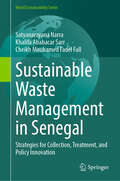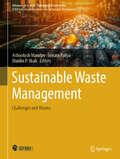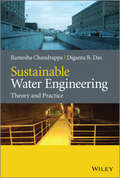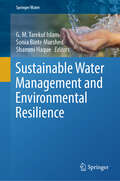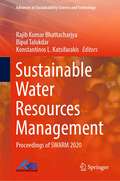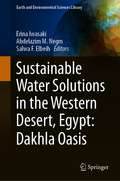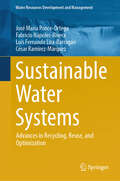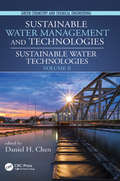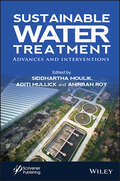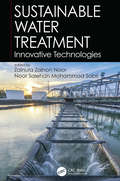- Table View
- List View
Sustainable Utilisation and Bioengineering of Halophytes (Sustainable Development and Biodiversity #38)
by Marius-Nicusor Grigore Jaya Arora Abhishek JoshiThis book provides a comprehensive overview of the cutting-edge research in the bioengineering of halophytes, with a particular focus on advancements in biotechnology, transcriptomics, proteomics, metabolomics, and genomics. Halophytes are a unique group of plants that have adapted to grow in extreme environmental conditions such as high salt, low water, and high temperatures. In desert conditions, these plants are crucial for supporting animal and human life. However, overexploitation of these plants degrades the ecosystem. Sustainable utilization and improvement of these plants through modern tools are essential for the sustainability of both the plants and the environment. Halophytes possess unique metabolic and physiological features, making them an attractive target for bioengineering. Recent advancements in bioengineering have significantly enhanced the study and manipulation of halophytes. By exploring the intricacies of these technologies, this book addresses key questions and challenges in harnessing the potential of halophytes for sustainable plant resources, environmental remediation, and novel biotechnological applications. This book will be valuable for researchers in plant biology, environmental studies, desertification, plant improvement, and biotechnology.
Sustainable Utilization and Conservation of Africa’s Biological Resources and Environment (Sustainable Development and Biodiversity #32)
by Sylvester Chibueze Izah Matthew Chidozie OgwuThis edited book highlights the potential and actual contributions of the sustainable management and utilization of indigenous biological resources and environment for the development of Africa. The book centers on documenting current trends and issues in the field of resource use and conservation with the view of emphasizing their benefits to the pursuit of development within the region. By documenting the array of natural resources and environment in Africa, this book addresses the topical knowledge and understanding gaps that characterize conservation (rationale for sustainable resource exploration), utilization patterns, and conservation challenges including policy status, environmental threats, impacts of tourism, reduction in food resources, etc., and their effects on the sustainable development of Africa. Through an integrated approach, the book focuses on below and above-ground biological resources and the diverse scales of environment that characterize Africa. This collection of works is very helpful for natural and social scientists, policymakers, strategists, researchers, government and non-government organizations, biodiversity and environmental managers, climate change scientists, practitioners, activists, conservationists, academics, ecologists, undergraduate and postgraduate students, and others who want to learn about and understand the best way to use and protect Africa's resources and heritage sustainably.
Sustainable Utilization and Conservation of Plant Genetic Diversity (Sustainable Development and Biodiversity #35)
by Shri Mohan Jain Jameel M. Al-Khayri Suprasanna PennaThis book collates a wide spectrum of topics relevant to contemporary research achievement in sustainable utilization of plant genetic resources and conservation of plant genetic diversity within the framework of different crop systems. It introduces the status of crop genetic diversity and provides prospects for conservation of crop genetic diversity for sustainable agriculture. Plant genetic diversity is crucial for food security and agro-ecosystem maintenance paving ways to achieve sustainable agriculture development. This necessitates, consciously and judiciously, the conservation of all existing plant genetic resources for sustainable use in a variety of applications for human welfare. The wild and traditional landraces have generated an increased interest as a repertoire of valuable traits for breeding and improvement of cultivated germplasm. Internationally, concerted actions and policies toward for the conservation and management of plant genetic diversity are mounting, fromthe organization levels to national policies as deemed appropriate for the sustainable development goals. This needs an understanding of genetic diversity of different crops, ecological drivers and the structural changes within genetic diversity due to climate change. It is also equally important to evolve knowledge on what, how and where to conserve the existing plant genetic resources for present and future use. Assessment of the genetic diversity presents in a wild and traditional agro-ecosystem is another step towards effective utilization. In the past few years, advanced breeding tools have been developed which have offered great promise for efficient modification of targeted traits. This book consolidates current knowledge in the above core areas of plant genetic diversity and conservation. It is an essential reference for professionals, researchers, policy makers and commercial entrepreneurs concerned with plant genetic diversity and breeding to achieve enhanced agricultural productivity and sustainability of food resources to ensure food security. The book is also invaluable for graduate students involved in agriculture research.
Sustainable Utilization of Carbon Dioxide: From Waste to Product (Sustainable Materials and Technology)
by Mohammad Jawaid Anish KhanThis book covers the latest technology and experimental scientific advancements in converting carbon dioxide (CO2) from waste to useful commercial products. This approach helps to mitigate climate change due to carbon emission greenhouse effect and also create a circular economy through CO2 waste capture and utilization to produce CO2 derived products. This provides new direction for government organizations, manufacturing industries (fuel, chemicals, building materials) and investment firms to work towards a zero carbon future. This book caters to researchers, policymakers, industrial practitioners who are interested in more sustainable practices in carbon dioxide technology.
Sustainable Utilization of Natural Gas for Low-Carbon Energy Production: Attaining Low-Carbon Energy Production Through Sustainable Natural Gas Utilization (Green Energy and Technology)
by Bamidele Victor Ayodele Siti Indati Mustapa Samuel Asumadu SarkodieThis book presents a detailed analysis of sustainable utilization of natural gas for low-carbon energy production. Its content is divided into three parts with the intention to address natural gas supply chain, technological advances in natural gas utilization, and role of natural gas in transition to a low-carbon economy. In particular, it describes the various technological pathways for the conversion of natural gas to valuable products such as hydrogen, syngas and other alternative fuel, which can be used as chemical intermediates or for co-generation of electricity and heat. This book is targeted at wide audience in the academia and industries who want a comprehensive knowledge of how natural gas can be sustainable utilized for low-carbon energy production.
Sustainable Utilization of Natural Resources
by Prasenjit Mondal Ajay K. DalaiIncreased research is going on to explore the new cleaner options for the utilization of natural resources. This book aims to provide the scientific knowhow and orientation in the area of the emerging technologies for utilization of natural resources for sustainable development to the readers. The book includes production of energy and lifesaving drugs using natural resources as well as reduction of wastage of resources like water and energy for sustainable development in both technological as well as modeling aspects.
Sustainable Valorization of Agriculture & Food Waste Biomass: Application in Bioenergy & Useful Chemicals (Clean Energy Production Technologies)
by Dan Bahadur Pal Amit Kumar TiwariThis edited book focuses on agricultural and food waste biomass valorization in various fields such as energy and environment and the development of several other value-added products. The chapters in this book cover different areas like sources of agricultural and food wastes, recent trends on waste utilization, innovations and sustainability of techniques, and challenges associated with valorization of wastes. In the last few decades, scientists and researchers of different countries predicted that waste material generated due to global problems can be used as a potential feeding material for the manufacturing of different valuable products. Hence, there is a need for more research and development of several other value-added products from waste materials. Proper utilization of these waste materials has been discussed in this book. It also covers the bioactive recovery from food waste, health benefits of extracted bioactive, and utilization of valorized products. The book also explores future technological challenges and sustainability issues. This title is a great resource for environmental and chemical engineers, food scientists, food researchers and technologists, as well as for students and professionals working in this field.
Sustainable Value Creation in the Fine and Speciality Chemicals Industry
by R. RajagopalThe global fine and speciality chemicals industry is a vital segment within the chemical value chain,catering to a multitude of societal and industrial needs. Regulatory, sustainability and consumer forces have been constantly shaping the business fundamentals of this industry. Developing value creation strategies, which embed economic, environmental and social sustainability components, will need a comprehensive assessment of business, scientific and technological challenges facing the industry.Sustainable Value Creation in the Fine and Speciality Chemicals Industry assesses sustainable value creation options against the backdrop of global mega trends that are defi ning the present and future course of the industry. It discusses innovative strategies in feedstocks, R&D, technology, manufacturing, resource management and the supply chain as well as the significance of the bio-based chemical economy in enabling sustainable value creation in the fine and speciality chemicals industry.Topics covered include:* Transformation in the fine and speciality chemicals business* Sustainable management: evolution, transitions and tools* Research and technology directions* Resource optimization strategies* Bio-based chemicals, specialities and polymers* Sustainable practices in the fine and speciality chemicals industry* Sustainable value creation strategiesSustainable Value Creation in the Fine and Speciality Chemicals Industry presents a comprehensiveoverview of strategic options for sustainability management in the global fine and speciality chemicals industry. It will be a valuable resource for chemists and chemical engineers involved in the design and development of economically, environmentally and socially sustainable practices for the future.
Sustainable Value Management for Construction Projects
by Ayodeji E. Oke Clinton O. AigbavboaThis book provides a unique guide to value management and sustainability in construction to researchers and professional. The book provides a better understanding of the concept of value management, the basis of sustainable construction and thereafter, demonstrates how using the principles of value management can help to achieve successful construction projects that are financially viable, socially beneficial and do not damage the environment.The book serves as an introduction to value management for scholars and researchers at all levels; and also as a practical guide for construction professionals, employers and other stakeholders in the construction industry.
Sustainable Values, Sustainable Change: A Guide to Environmental Decision Making
by Bryan G. NortonSustainability is a nearly ubiquitous concept today, but can we ever imagine what it would be like for humans to live sustainably on the earth? No, says Bryan G. Norton in Sustainable Values, Sustainable Change. One of the most trafficked terms in the press, on university campuses, and in the corridors of government, sustainability has risen to prominence as a buzzword before the many parties laying claim to it have come close to agreeing how to define it. But the term's political currency urgently demands that we develop an understanding of this elusive concept. While economists, philosophers, and ecologists argue about what in nature is valuable, and why, Norton here offers an action-oriented, pragmatic response to the disconnect between public and academic discourse around sustainability. Looking to the arenas in which decisions are made--and the problems that are driving these decisions--Norton reveals that the path to sustainability cannot be guided by fixed, utopian objectives projected into the future; sustainability will instead be achieved through experimentation, incremental learning, and adaptive management. Drawing inspiration from Aldo Leopold's famed metaphor of "thinking like a mountain" for a spatially explicit, pluralistic approach to evaluating environmental change, Norton replaces theory-dependent definitions with a new decision-making process guided by deliberation and negotiation across science and philosophy, encompassing all stakeholders and activists and seeking to protect as many values as possible. Looking across scales to today's global problems, Norton urges us to learn to think like a planet.
Sustainable Waste Management Practices for the Mining Sector Through Recycling of Mining Waste (SpringerBriefs in Earth System Sciences)
by Suchismita Satapathy Meghana Mishra Manas R. DasMining waste management is an important issue for the mining industry since it entails the safe and responsible disposal of waste created during mining operations. This waste comprises tailing, waste rock, and other mining wastes that, if not adequately managed, can pose environmental and health problems. Effective waste management solutions are required to reduce the environmental impact of mining and preserve the long-term viability of mining operations. These initiatives include improving mining practices to reduce waste generation, establishing effective waste treatment and disposal systems, and participating in community outreach and education programme. In recent years, there has been a growing emphasis on the use of new mining waste management technologies and practices. The adoption of modern filtration systems, bio-remediation techniques, and the rehabilitation of abandoned mining sites are examples of these. Overall, good mining waste management is critical for guaranteeing the mining industry; long-term sustainability and protecting the environment and communities where mining operations take place. Sustainable waste management is the implementation of practices and strategies that aim to minimize aim the negative impact of mining waste while promoting resource efficiency and long-term economic viability it involves employing a thorough approach that considers the entire mining waste lifetime, from generation to disposal, and seeks to reduce waste generation, reuse, or recycle items, and appropriately dispose of any remaining rubbish. It attempts to extend the life of materials while reducing the waste volume that is incinerated or dumped in landfills. To lessen the detrimental environmental, economic, social and effects in consumption, a thorough approach to sustainable waste management must concentrate on the life cycle of a product. Mining wastes can be categorized into overburden, waste rock, tailings and mine water. During mineral extracted, beneficiated, and processed, mining wastes are produced. The first stage, known as extraction, which is the first layer sacking of minerals. Typically, blasting is used to do this, which produces a significant amount of garbage (soil, debris and other material). This is usually only concentrated within the periphery of a mine rental place and occasionally on public land, and is useless to the industry. The amount of waste produced increases with the size of the mine. Because they produce far more trash than underground mines, opencast mines are consequently more pollutant-intensive. Use of tailing waste of iron mines with clay for producing bricks can lead to consumption of large quantities of the waste materials and managing it in an environmentally friendly way. On the other hand, it can reduce consumption of top soil for making bricks and improve construction materials availability. Similarly, for preparation of ceramics and polymer composite, these wastes can be used, which will help in solving social, environmental problem.
Sustainable Waste Management in Senegal: Strategies for Collection, Treatment, and Policy Innovation (World Sustainability Series)
by Satyanarayana Narra Khalifa Ababacar Sarr Cheikh Mouhamed FallTransforming Waste Management in Senegal: Strategies for a Sustainable Future Senegal faces a critical challenge in waste management, with 3.1 million tons of municipal solid waste (MSW) generated annually—45% of which remains uncollected. Addressing this issue requires a strategic, multi-divisional approach to waste minimization, collection, treatment, and sustainable disposal. This book provides a comprehensive roadmap for improving Senegal’s waste management sector. It examines the current organizational structure, explores technical solutions, and outlines innovative strategies for closing collection gaps, optimizing transportation, establishing centralized treatment facilities, and integrating digital solutions. Additionally, it emphasizes awareness campaigns, funding mechanisms, and policy enhancements to drive long-term impact. By offering data-driven insights and practical strategies, this guide supports policymakers, urban planners, and waste management professionals in making informed decisions to reduce landfill stress, promote circular economy practices, and pave the way for a cleaner, more sustainable Senegal.
Sustainable Waste Management: 7th IconSWM—ISWMAW 2017, Volume 1
by Sadhan Kumar GhoshThe book presents high-quality research papers from the Seventh International Conference on Solid Waste Management (IconSWM 2017), held at Professor Jayashankar Telangana State Agricultural University, Hyderabad on December 15–17, 2017. The conference, an official side event of the high-level Intergovernmental Eighth Regional 3R Forum in Asia and the Pacific, aimed to generate scientific inputs into the policy consultation of the Forum co-organized by the UNCRD/UNDESA, MoEFCC India, MOUD India and MOEJ, Japan. Presenting research on solid waste management from more than 30 countries, the book is divided into three volumes and addresses various issues related to innovation and implementation in sustainable waste management, segregation, collection, transportation of waste, treatment technology, policy and strategies, energy recovery, life cycle analysis, climate change, research and business opportunities.
Sustainable Waste Management: Challenges and Visions (Advances in Science, Technology & Innovation)
by Maulin P. Shah Ashootosh Mandpe Sonam PaliyaThis book explores different aspects associated with the genesis of solid waste management problems and brings forward the challenges posed by the solid waste management sector and its impact on the environment. Additionally, the book discusses various effects of improper waste management practices considering the environmental, social, governance, engineering, and management aspects emphasizing on waste minimization strategies and circular economy approaches. This book encapsulates numerous ideas for developing novel strategies towards sustainable waste management, incorporating technology transfer and capacity building for sustainable waste management, and enforcing the stringent policy framework for environmental protection from improper waste management practices. This book is an essential resource for researchers and students studying solid waste management, waste valorization, biorefineries, biofuels/products/processes, as well as for geo-environmental engineers, biochemical/chemical engineers, and biotechnologists working in industries and government agencies, policy makers, conservationists, NGOs working for environment protection, etc.
Sustainable Waste Utilization in Bricks, Concrete, and Cementitious Materials: Characteristics, Properties, Performance, and Applications (Lecture Notes in Civil Engineering #129)
by Shahiron Shahidan Aeslina Abdul Kadir Noor Amira SaraniThis book highlights the current research, conceptual and practical utilization of waste in building materials. It examines the production of industrial and agricultural wastes that have been generated worldwide and have significant environmental impact. The book discusses how to incorporate these wastes effectively with greener technology and how to address its environmental impact in order to produce environmentally friendly and sustainable green products. This book also will capitalize on its practical application, properties, performance and economic advantages. The topics covered include the physical, mechanical and environmental properties, leaching behaviour, gas emissions and performance of sustainable construction materials. This book offers a valuable reference for researchers, industries and interested stakeholders in sustainable construction or any allied fields.
Sustainable Water Engineering
by Diganta B. Das Ramesha ChandrappaEnsuring safe and plentiful supplies of potable water (both now and for future generations) and developing sustainable treatment processes for wastewater are among the world's greatest engineering challenges. However, sustainability requires investment of money, time and knowledge. Some parts of the world are already working towards this goal but many nations have neither the political will nor the resources to tackle even basic provision and sanitation. Combining theory and practice from the developing and developed worlds with high- and low-tech, high- and low-cost solutions, this book discusses fundamental and advanced aspects of water engineering and includes: water resource issues including climate change, water scarcity, economic and financial aspects requirements for sustainable water systems fundamentals of treatment and process design industrial water use and wastewater treatment sustainable effluent disposal sustainable construction principles With integrated theory, design and operation specifications for each treatment process, this book addresses the extent to which various treatment methods work in theory as well as how cost effective they are in practice. It provides a nontechnical guide on how to recover and reuse water from effluent, which is suitable for those in water resource management, environmental planning, civil and chemical engineering.
Sustainable Water Management (Green Chemistry and Chemical Engineering)
by Daniel H. ChenWhile the world’s population continues to grow, the availability of water remains constant. Facing the looming water crisis, society needs to tackle strategic management issues as an integrated part of the solution toward water sustainability. The first volume in the two-volume set Sustainable Water Management and Technologies offers readers a practical and comprehensive look at such key water management topics as water resource planning and governance, water infrastructure planning and adaption, proper regulations, and water scarcity and inequality. It discusses best management practices for water resource allocation, ground water protection, and water quality assurance, especially for rural, arid, and underdeveloped regions of the world. Timely topics such as drought, ecosystem sustainability, climate change, and water management for shale oil and gas development are presented. Discusses best practices for water resource allocation, ground water protection, and water quality assurance. Offers chapters on urban, rural, arid, and underdeveloped regions of the world. Describes timely topics such as drought, ecosystem sustainability, climate change, and water management for shale oil and gas development. Covers water resource planning and governance, water infrastructure planning and adaptation, proper regulations, and water scarcity and inequality Discusses water resource monitoring, efficiency, and quality management.
Sustainable Water Management and Environmental Resilience (Springer Water)
by G. M. Tarekul Islam Sonia Binte Murshed Shammi HaqueThis book focuses on sustainable water management perspective and how to use this knowledge to ensure resilient development. Sustainable water resource management is an essential aspect of resilient development as it helps to ensure the availability and accessibility of safe, clean, and equitable water for both present and future generations. Implementing sustainable water management practices is crucial to address the increasing water issues caused by climate change, urbanization, and population growth. This book focuses on specific areas where meticulous water resource-related factors intermingle with societal needs and thus fulfills the demand of the greater humanity. Water security, hydrometeorological forecasting and warning, ecosystem services and functions, transboundary conflicts and opportunities for cooperation in common/ mutual interests, sustainable fisheries, and water management are some of the focusing areas of this book that firmly connects science and society. The book is a collection of selected papers from the 9th International Conference on Water and Flood Management (ICWFM). ICWFM has been held biennially since 2007 by the Institute of Water and Flood Management (IWFM) of Bangladesh University of Engineering and Technology (BUET).
Sustainable Water Resources Management: Proceedings of SWARM 2020 (Advances in Sustainability Science and Technology)
by Rajib Kumar Bhattacharjya Bipul Talukdar Konstantinos L. KatsifarakisThis book brings high-quality selected research articles from the international conference on Sustainable Water Resources Management (SWARM 2020), held at Assam Engineering College, Guwahati, Assam, India, during 19–21 June 2020. The book focuses on water management and planning, urban water management, climate change and global warming, management of groundwater and aquifer remediation, water conservation, water quality, pollution control, management of trans-boundary rivers, advanced hydrological modelling and hydro-disaster risk management of sustainable water management.
Sustainable Water Solutions in the Western Desert, Egypt: Dakhla Oasis (Earth and Environmental Sciences Library)
by Abdelazim M. Negm Salwa F. Elbeih Erina IwasakiThis book is a multidisciplinary manuscript bringing together contributions on water issues from natural and social scientists focused on water management and structures in a challenging environmental situation such as Dakhla Oasis in Egypt's western desert. The authors of this book are relevant scientists in hydrology, geology, remote sensing, agriculture, history, and sociology. It is devoted to various critical environmental topics such as geological and hydraulic structure, climate influence, underground water management, irrigation management, and human settlement. The book provides a range of new perspectives on solving different environmental problems in arid zones toward the region's sustainable development, based on the case studies and fieldwork in the Dakhla Oasis (Western Desert, Egypt).
Sustainable Water Systems: Advances in Recycling, Reuse, and Optimization (Water Resources Development and Management)
by José María Ponce-Ortega César Ramírez-Márquez Fabricio Nápoles-Rivera Luis Fernando Lira-BarragánThis book explores advanced recycling and optimization techniques, offering a blend of practical case studies and theoretical models that push the boundaries of traditional water management practices. Each chapter covers various aspects of sustainable water management, from the reuse of wastewater in residential complexes to the design of eco-industrial parks. By integrating environmental engineering, economics, and urban planning, the book addresses the pressing need for sustainable water solutions, presenting cutting-edge optimization models and economic analyses crucial for professionals and decision-makers. The incorporation of dynamic and strategic planning in the context of environmental constraints and uncertainties makes it an essential resource for navigating the complexities of modern water systems. Providing innovative strategies for a sustainable future, this book stands as a pivotal work in the field of water resource management.
Sustainable Water Technologies (Green Chemistry and Chemical Engineering)
by Daniel H. ChenDevelopment of advanced technologies is a critical component in overcoming the looming water crisis. Stressing emerging technologies and strategies that facilitate water sustainability for future generations, the second volume in the two-volume set Sustainable Water Management and Technologies provides current and forthcoming technologies research, development, and applications to help ensure availability of water for all. The book emphasizes emerging nanotechnology, biotechnology, and information technology applications as well as sustainable processes and products to protect the environment and human health, save water and energy, and minimize material use. It also discusses such topics as groundwater transport, protection, and remediation, industrial and wastewater treatment, reuse, and disposal, membrane technology for water purification and desalination, treatment and disposal in unconventional oil and gas development, biodegradation, and bioremediation for soil and water. Stresses emerging technologies and strategies that facilitate water sustainability. Covers a wide array of topics including drinking water, wastewater, and groundwater treatment, protection, and remediation. Discusses oil and gas drilling impacts and pollution prevention, membrane technology for water desalination and purification, biodegradation, and bioremediation for soil and water. Details emerging nanotechnology, biotechnology, and information technology applications, as well as sustainable processes and products.
Sustainable Water Treatment: Advances and Interventions
by Siddhartha Moulik Anirban Roy Aditi MullickSUSTAINABLE WATER TREATMENT This outstanding new volume is a compendium of reference material which will cover most of the relevant and state-of-art approaches in the field of water treatment, focusing on technological advances for water treatment in four categories: advanced oxidation technologies, nanoparticles for water treatment, membrane separations, and other emerging technologies or processes. Apart from this perspective, fundamental discussions on a wide variety of pollutants have also been included, such as acidic wastewater treatment, metallurgical wastewater, textile wastewater as well as groundwater. The editors have not only covered a wide range of water treatment techniques, but also focus on their applications, offering a holistic perspective on water treatment in general. Covering all of the latest advances, innovations, and developments in practical applications for sustainable water treatment, this volume represents the most comprehensive, up-to-date coverage of the issues of the day and state of the art. Whether for the veteran engineer or scientist or a student, this volume is a must-have for any library. Sustainable Water Treatment: Advances and Interventions covers: Provides an insight into various sectors of water and wastewater treatment technologies, introducing key technical topics Is a comprehensive guide to technological interventions for water and wastewater treatment Is also a reference book for any elective course on water treatment for engineers, scientists, and students, at both the undergraduate and graduate levels Presents the most current and up-to-date advances in sustainable water treatment Covers key technical topics and gives readers a comprehensive understanding of the latest research findings Includes perspectives on future trends and challenges
Sustainable Water Treatment: Innovative Technologies
by Zainura Zainon Noor and Noor Salehan Mohammad SabliThis book focuses on green and innovative wastewater treatment technologies that promote sustainability. It discusses a variety of biological, physical, and chemical treatment technologies. It covers biological processes for recovery of value-added products from wastewater and gives an overview of enzymatic hydrolysis and bioremediation of wastewater using immobilized enzyme and fungus. It offers a case study and future trends of wastewater treatment through membrane bioreactor technologies, describes advanced chemical–physical processes for recalcitrant pollutant, and emphasizes the use of low-cost materials and cost-effective treatment methods.
Sustainable Water and Environmental Management in the California Bay-Delta
by Committee on Sustainable Water Environmental Management in the California Bay-DeltaExtensively modified over the last century and a half, California's San Francisco Bay Delta Estuary remains biologically diverse and functions as a central element in California's water supply system. Uncertainties about the future, actions taken under the federal Endangered Species Act (ESA) and companion California statues, and lawsuits have led to conflict concerning the timing and amount of water that can be diverted from the Delta for agriculture, municipal, and industrial purposes and concerning how much water is needed to protect the Delta ecosystem and its component species. Sustainable Water and Environmental Management in the California Bay-Delta focuses on scientific questions, assumptions, and conclusions underlying water-management alternatives and reviews the initial public draft of the Bay Delta Conservation Plan in terms of adequacy of its use of science and adaptive management. In addition, this report identifies the factors that may be contributing to the decline of federally listed species, recommend future water-supple and delivery options that reflect proper consideration of climate change and compatibility with objectives of maintaining a sustainable Bay-Delta ecosystem, advises what degree of restoration of the Delta system is likely to be attainable, and provides metrics that can be used by resource managers to measure progress toward restoration goals.
